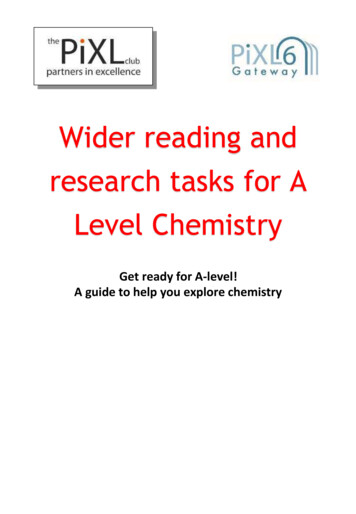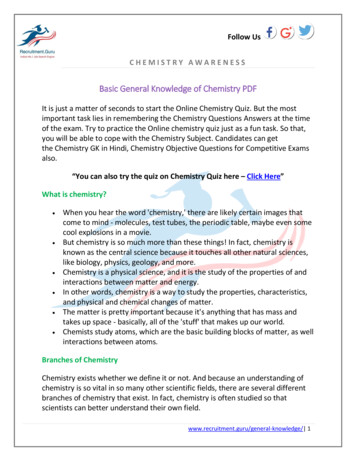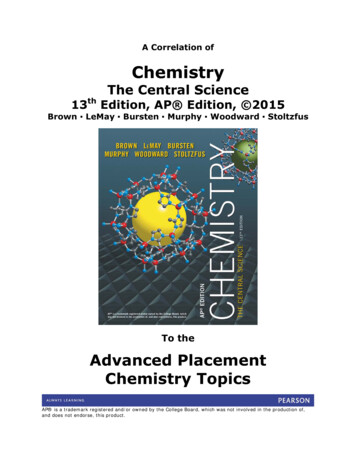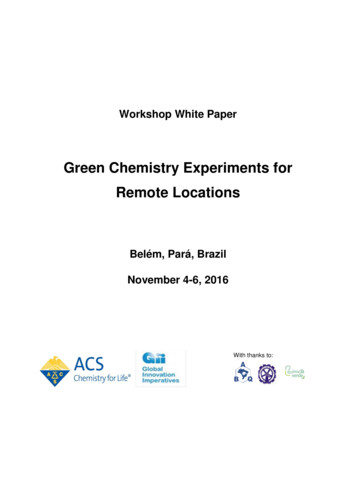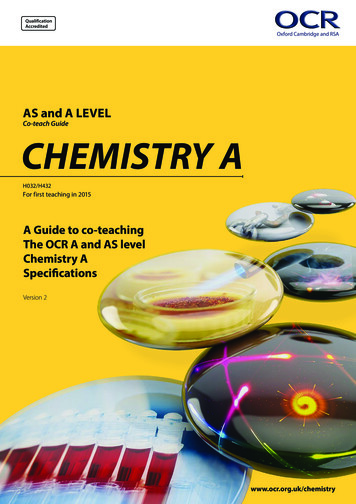
Transcription
QualificationAccreditedOxford Cambridge and RSAAS and A LEVELCo-teach GuideCHEMISTRY AH032/H432For first teaching in 2015A Guide to co-teachingThe OCR A and AS levelChemistry ASpecificationsVersion 2www.ocr.org.uk/chemistry
AS AND A LEVEL CHEMISTRY AGUIDE TO CO-TEACHINGCONTENTSINTRODUCTION PAGE 3THE NEW QUALIFICATIONS PAGE 4SUGGESTED PLANNER PAGE 52 OCR 2016
AS AND A LEVEL CHEMISTRY AGUIDE TO CO-TEACHINGINTRODUCTIONThe OCR AS and A Level specifications in Chemistry A aredeliberately structured to facilitate co-teaching. As such theyhave been designed to be as accessible as possible for teachers. Both AS and A level specifications share the same:Assessment Objectives, assessment aims and learningoutcomes. There is the same approach to the subjectapparent at each level. The content of the AS Level specification is a subset of thecontent of the A Level specification, which can be taughtin the first year of the A Level course. This allows AS and ALevel learners to be taught together throughout the firstyear until the AS assessments. Assessment will contain the same question types (multiplechoice questions, structured questions, extended responsequestions), allowing similar materials to be used in revisionand exam preparation. The creative and innovative teaching and learning resourcesbeing developed by OCR will be equally useful for AS and ALevel learners in the first year.3 OCR 2016
AS AND A LEVEL CHEMISTRY AGUIDE TO CO-TEACHINGTHE NEW QUALIFICATIONSThe AS in Chemistry A is a separate qualification to the GCE A Level in the subject. Its structure does, however, reflect that of theA Level. The content of the A Level in Chemistry A is divided into 6 teaching modules. The content of the AS Level in ChemistryA consists of the first four teaching modules of the full A level, with exception of the internally assessed practical skills covered inModule 1.Learners are not required to sit the AS Level before proceeding to the A Level, as in the current ‘legacy’ system. If learners do take theAS Level and then move on to the A Level, this means that they will be reassessed on material that they have already covered at AS.The experience of sitting the AS Level could therefore be useful practice for taking the A Level components. This is true in terms ofquestion types as well as content, as can be seen from the summaries of the papers for each qualification in the table below.AS paper 1Breadth inchemistryAS Paper 2Depth inChemistryA level Paper 1Periodic table,elementsand physicalchemistryA level Paper 2 A level Paper 3Synthesis s1.5 hours/701.5 hours/702.25 hours/1002.25 hours/1001.5 hours/70Multiple choice20 marks–15 marks15 esYesSpecificationcoverageSection 1.1, Modules 2–4Section 1.1,Modules 2,3,5Section 1.1,Modules 2,4,6Section 1.1,Modules 2–6In addition to the three externally assessed examinations, theA Level assessment includes the Practical Endorsement, whichis internally assessed by the centre and externally moderated.The Practical Endorsement is reported separately from theoverall grade issued for the A Level, which is determined byperformance in the examinations.AS and A Level Chemistry. AS learners will benefit from takingpart in the practical activities, and will be able to count theirperformance (as long as adequate records are kept) towards theA Level Practical Endorsement if they decide to proceed to thefull A Level after taking the AS examinations. OCR recommendsthat AS learners join in with any Practical Endorsement activitiesundertaken in the first year of the A Level course.PRACTICAL SKILLSSUMMARYOfqual has decided that there will be no direct assessment ofpractical skills in AS Chemistry qualifications. There is thereforeno internally assessed practical assessment in the OCR ASmodel. This does not mean that the development of practicalskills should not form part of the teaching and learning at thislevel. Practical skills will be assessed in the written examinationsat both AS and A Level.Taken together, these factors all ensure that the AS and A Levelin Chemistry A can be co-taught such that members of thesame Year 12 (or equivalent) teaching group are able to followthe same Scheme of Learning – delivered by the same teacheror teachers – whether individual learners are planning:OCR have embedded practical skills into the AS and A LevelChemistry A specifications, so that practical activities maybe easily integrated into the teaching of the course, and willsupport the teaching and assessment of the content of both4 either to sit the subject at AS and then drop it completely or to sit AS Chemistry A with a view to going on to take ALevel the following year or to go through to take A Level without sitting the ASexams at the ‘half-way’ stage. OCR 2016
AS AND A LEVEL CHEMISTRY AGUIDE TO CO-TEACHINGSUGGESTED PLANNERBelow are two possible planners for teaching both years of the course, with the AS course co-taught alongside the first year of A Level. The first planner assumes a single teacher delivering theentire course, while the second planner assumes the course is delivered by two teachers with the content split equally. These planners will need to be adapted to fit the needs of the individualcentre. It should always be possible to teach the AS and A Level at the same time within a centre.Following these two planners is a third, which offers a suggestion for how to plan the A Level course if AS will not be co-taught.N.B. In the tables the abbreviation ‘PAG’ stands for ‘Practical Activity Group’, and refers to the groups defined in appendix 5g of the A Level specification.PLANNER 1: AS AND A LEVEL CO-TAUGHT BY ONE TEACHERTimelineContentNotesThroughoutcourseModule 1 –Development ofpractical skills inchemistryTeaching of Specification Section 1.1 – Practical skills assessed in a written examination should be embedded in teaching throughout viasupporting practical work, ideally combined with teaching of the practical techniques and procedure included in Modules 2–6.Carefully chosen practical work can be used to develop and assess competency in practical skills as part of the Practical Endorsement, as outlinedin section 1.2.Year 1, Term 1Module 2 –Foundations inchemistrySupporting practical work: experiments requiring measurement of mass and volume (liquids, solutions and gases), and calculations related to amount of substance(PAG1) (redox) reactions of acids acid–base titrations (PAG2)Module 3,Section 3.1 – Theperiodic tableSupporting practical work: reactions of Group 2 elements reactions of halogens and halide displacement reactions qualitative analysis of inorganic ions (PAG4)Module 3,Section 3.2 –Physical chemistrySupporting practical work: determination of enthalpy changes (PAG3) investigation of reaction rates (more extensive work on reaction rates in the second year of A Level will count towards PAG9 and PAG10) investigation of changes to the position of equilibrium in response to changes in concentration, temperature and in the presence of a catalystYear 1, Term 25 OCR 2016
AS AND A LEVEL CHEMISTRY AGUIDE TO CO-TEACHINGTimelineContentNotesYear 1, Term 2Module 4,Section 4.1 – Basicconcepts andhydrocarbons;start Section4.2 – Alcohols,haloalkanes andanalysisSections 4.2.1 and 4.2.2Supporting practical work: reaction of bromine with cyclohexane and cyclohexene reactions of alcohols reactions of haloalkanes qualitative analysis of organic functional groups (PAG7; more work may be done in the second year of A Level)Module 4,complete Section4.2Sections 4.2.3 and 4.2.4Supporting practical work: synthesis and purification of an organic liquid (PAG5)Revision andpreparation for ASexamsA Level learners not taking AS exams might use this period to consolidate A Level study at the midpoint of the course, or to complete trial examsas an indicator of progress.Additionally, learners might be given more extensive practical work – e.g. a more extended organic synthesis including risk assessment andanalysis – to complete while AS candidates are revising; this will benefit skills development for the Practical Endorsement.Another strategy might be to study Module 5 Rates and to complete one of the rates investigations for the Practical Endorsement.Post AS examsA Level learners (and AS candidates who are considering continuing with A Level) might start on the A Level modules.Year 2, Term 1Module 5 – Physicalchemistry andtransition elementsSupporting practical work: investigation of reaction rates using both initial rate and continuous monitoring methods (PAG9, PAG10) determination of quantities present in a mixture at equilibrium measurement of pH (PAG11) redox titrations measurement of cell potentials (PAG8) ligand substitution, precipitation and redox reactions for transition metal ions and complexesYear 2, Term 2Module 6 – Organicchemistry andanalysisSupporting practical work: reactions of carbonyl compounds and esters qualitative analysis of organic functional groups (PAG7) synthesis and purification of an organic solid (PAG6) completion of Practical Endorsement (if required; PAG12 if not yet completed)(continued)Year 1, Term 36 OCR 2016
AS AND A LEVEL CHEMISTRY AGUIDE TO CO-TEACHINGTimelineContentNotesYear 2, Term 3Thorough revisionExam preparationand consolidation ofall A Level contentN.B. Centres may wish to switch teaching of Modules 5 and 6 in Year 2, enabling a more natural transition between the organic chemistry modules.PLANNER 2: AS AND A LEVEL CO-TAUGHT BY TWO TEACHERSTimelineContentNotesThroughout course Module 1 – Development of practical skills in chemistryTeaching of Specification Section 1.1 – Practical skills assessed in a written examinationshould be embedded in teaching throughout via supporting practical work, ideallycombined with teaching of the practical techniques and procedures included inModules 2–6.Carefully chosen practical work can be used to develop and assess competency inpractical skills as part of the Practical Endorsement, as outlined in Section 1.2.Teacher 1Year 1, Term 1Teacher 2ContentNotesContentNotesModule 2, Section 2.1.1 – Atomicstructure and isotopesSupporting practical work:Supporting practical work:Section 2.1.3 – Amount of substance Module 2,Section 2.1.2 – Compounds, formulaeand equationsSection 2.1.4 – Acidsexperiments requiringmeasurement of mass andvolume (liquids, solutions andgases), and calculations relatedto amount of substance (PAG1) reactions of acids acid–base titrations (PAG2)Section 2.2 – Electrons, bonding andstructureSection 2.1.5 – RedoxSupporting practical work:Section 3.1.2 – Group 2 reactions of Group 2 elements7redox reactions of acidsSome practicals to support content inTeacher 1 strand could be carried out byTeacher 2 to break up the content in thisstrand.Ideally, both teachers would finishteaching of Module 2 at the sametime.Module 3, Section 3.1.1 – Periodicity Module 4, Section 4.1.1 – Basicconcepts of organic chemistry OCR 2016
AS AND A LEVEL CHEMISTRY ATimelineContentYear 1, Term 2Module 3,Remainder of Section 3.1Year 1, Term 3GUIDE TO CO-TEACHINGNotesSupporting practical work:Module 4,Supporting practical work: reactions of halogens and halidedisplacement reactionsRemainder of Section 4.1 reaction of bromine with cyclohexaneand cyclohexene qualitative analysis of inorganicions (PAG4)Section 4.2.1 – Alcohols reactions of alcoholsSection 4.2.2 – Haloalkanes reactions of haloalkanesSection 3.2.1 – Enthalpy changes determination of enthalpychanges (PAG3) Section 3.2.2 – Reaction rates investigation of reaction rates(more extensive work onreaction rates in the second yearof A Level will count towardsPAG9 and PAG10)qualitative analysis of organic functionalgroups (PAG7; more work may be done inthe second year of A Level)Module 3,Section 3.2.3 – Chemical equilibriumSuggested practical work: investigation of changes tothe position of equilibriumin response to changes inconcentration, temperature andin the presence of a catalystRevision and preparation for AS examsA Level learners not taking AS exams might use this period to consolidate A Level study at the midpoint of the course, or tocomplete trial exams as an indicator of progress.Module 4,Remainder of Section 4.2Suggested practical work: synthesis of an organic liquid (PAG5)Additionally, learners might be given more extensive practical work – e.g. a more extended organic synthesis including riskassessment and analysis – to complete while AS candidates are revising; this will benefit skills development for the PracticalEndorsement.Another strategy might be to study Module 5 Rates and to complete one of the rates investigations for the PracticalEndorsement.Post AS examsA Level learners (and AS candidates who are considering continuing with A Level) might start on the A Level modules.8 OCR 2016
AS AND A LEVEL CHEMISTRY ATimelineContentYear 2, Term 1Module 5,Section 5.1 – Rates, equilibrium and pHYear 2, Term 2Module 5,Section 5.2 – EnergySection 5.3 – Transition elementsYear 2, Term 3Thorough revision and consolidation ofall A Level content.GUIDE TO CO-TEACHINGNotesSuggested practical work: investigation of reaction ratesusing both initial rate andcontinuous monitoring methods(PAG9, PAG10) determination of quantitiespresent in a mixture atequilibrium measurement of pH (PAG11)Module 6,Section 6.1 – Aromatic compounds,carbonyls and acidsSection 6.2.1 - Aminesqualitative analysis of organic functionalgroups (PAG7)Suggested practical work: redox titrations measurement of cell potentials(PAG8)Module 6,Remainder of Section 6.2Suggested practical work: synthesis of an organic solid (PAG6)Section 6.3 – Analysis qualitative analysis of organic functionalgroups (PAG7) completion of Practical Endorsement (ifrequired; PAG12 if not yet completed). ligand substitution, precipitationand redox reactions qualitative analysis of inorganicions (PAG4) completion of PracticalEndorsement (if required; PAG12if not yet completed).Exam preparationThorough revision and consolidationof all A Level content.9Suggested practical work:reactions of carbonyl compounds and estersExam preparation OCR 2016
AS AND A LEVEL CHEMISTRY AGUIDE TO CO-TEACHINGPLANNER 3: LINEAR A LEVEL NOT CO-TAUGHT WITH ASThe following planner is intended to be very flexible. It illustrates how teaching of topics from Modules 3 and 5 (inorganic and physical chemistry), as well as topics from Modules 4 and 6 (organicand analytical chemistry) can be combined in a logical way. The order of the various topics can easily be changed to alternate the two strands; alternatively, the planner is straightforward to adaptfor delivery by two teachers, with one teaching inorganic/physical and the other organic/analytical. In that case, see Planner 2 for a suggestion on how to split teaching of Module 2.TimelineContentNotesThroughout course Module 1 –Development ofpractical skills inchemistryTeaching of Specification Section 1.1– Practical skills assessed in a written examination should be embedded in teaching throughout via supporting practical work, ideally combinedwith teaching of the practical techniques and procedures included in Modules 2–6.Carefully chosen practical work can be used to develop and assess competency in practical skills as part of the Practical Endorsement, as outlinedin Section 1.2.Year 1, Term 1Module 2 –Foundations inchemistrySupporting practical work: experiments requiring measurement of mass and volume (liquids, solutions and gases), and calculations related to amount of substance (PAG1) (redox) reactions of acids acid–base titrations (PAG2).Module 3,Section 3.1 – Theperiodic tableComplete Sections 3.1.1, 3.1.2 and 3.1.3.Supporting practical work: reactions of Group 2 elements reactions of halogens and halide displacement reactions.Module 5,start Section 5.2.3 –Redox and electrodepotentials;Section 5.3 –Transition elementsFrom Section 5.2.3 only Redox and Redox titrations, to follow on from the redox content in Section 3.1.Supporting practical work: redox titrations ligand substitution, precipitation and redox reactions for transition metal ions and complexes.Module 3,Section 3.1.4 –Qualitative analysis;Module 5,Section 5.3.2 –Qualitative analysisSupporting practical work: qualitative analysis of inorganic ions (PAG4).Year 1, Term 210 OCR 2016
AS AND A LEVEL CHEMISTRY AGUIDE TO CO-TEACHINGTimelineContentNotesYear 1, Term 2(continued)Module 3,Section 3.2.1 –Enthalpy changes;Module 5,complete Section5.2 – EnergyCombined teaching of all content on energetics.Supporting practical work: determination of enthalpy changes (PAG3).Module 3,Section 3.2.2 –Reaction ratesSupporting practical work: investigations of reaction rates.Module 5,Section 5.1.1 – Howfast?Supporting practical work: investigation of reaction rates using both initial rate and continuous monitoring methods (PAG9, PAG10).Module 3,Section 3.2.3– Chemicalequilibrium;Module 5,Section 5.1.2 – Howfar?;Section 5.1.3 – Acids,bases and buffersCombined teaching of all content on equilibrium, extending into acid–base equilibria.Supporting practical work: investigation of changes to the position of equilibrium in response to changes in concentration, temperature and in the presence of a catalyst determination of quantities present in a mixture at equilibrium measurement of pH (PAG11).Module 5,complete Section5.2.3 – Redox andelectrode potentialsElectrode potentials and Storage and fuel cells.Supporting practical work: measurement of cell potentials (PAG8).Year 1, Term 3End-of-first yeartests/mocksYear 2, Term 1Module 4,Section 4.1 – Basicconcepts andhydrocarbonsSupporting practical work: reaction of bromine with cyclohexane and cyclohexene.11 OCR 2016
AS AND A LEVEL CHEMISTRY AGUIDE TO CO-TEACHINGTimelineContentNotesYear 2, Term 1(continued)Module 4,Section 4.2.2 –HaloalkanesSupporting practical work: reactions of haloalkanes.Module 4,Section 4.2.1 –Alcohols;Module 6,Section 6.1.2– Carbonylcompounds;Section 6.1.3 –Carboxylic acids andestersCombined teaching of oxygen-containing organic classes.Supporting practical work: reactions of alcohols reactions of carbonyl compounds and esters.Year 2, Term 2Module 6,Section 6.1.1– AromaticcompoundsModule 6,Section 6.2– Nitrogencompounds,polymers andsynthesisComplete Sections 6.2.1, 6.2.2, 6.2.3 and 6.2.4.Module 4,Section 4.2.3 –Organic synthesis;Module 6,Section 6.2.5 –Organic synthesisSupporting practical work: synthesis of an organic liquid (PAG5) synthesis of an organic solid (PAG6).12 OCR 2016
AS AND A LEVEL CHEMISTRY ATimelineYear 2, Term 3GUIDE TO CO-TEACHINGContentNotesModule 6,Section 6.3.1 –Chromatographyand qualitativeanalysis;Module 4,Section 4.2.4– Analyticaltechniques;Module 6Section 6.3.2 –SpectroscopyTeaching of all analytical techniques combined. Section 6.3.1 placed first so qualitative analysis follows from organic chemistry, and to allowcombination of all content on spectroscopic techniques.Supporting practical work: qualitative analysis of organic functional groups (PAG7) completion of Practical Endorsement (if required; PAG12 if not yet completed).Thorough revisionExam preparationand consolidation ofall A Level content13 OCR 2016
The small printWe’d like to know your view on the resources we produce. Byclicking on the ‘Like’ or ‘Dislike’ button you can help us to ensurethat our resources work for you. When the email template popsup please add additional comments if you wish and then just click‘Send’. Thank you.If you do not currently offer this OCR qualification but would like todo so, please complete the Expression of Interest Form which can befound here: www.ocr.org.uk/expression-of-interestOCR Resources: the small printOCR’s resources are provided to support the teaching of OCRspecifications, but in no way constitute an endorsed teachingmethod that is required by the Board and the decision to usethem lies with the individual teacher. Whilst every effort is madeto ensure the accuracy of the content, OCR cannot be heldresponsible for any errors or omissions within these resources. Weupdate our resources on a regular basis, so please check the OCRwebsite to ensure you have the most up to date version. OCR 2016 – This resource may be freely copied and distributed,as long as the OCR logo and this message remain intact and OCR isacknowledged as the originator of this work.OCR acknowledges the use of the following content:Square down andSquare up: alexwhite/Shutterstock.comPlease get in touch if you want to discuss the accessibility ofresources we offer to support delivery of our qualifications:resources.feedback@ocr.org.ukWe will inform centres about any changes to the specification. Wewill also publish changes on our website. The latest version of ourspecification will always be the one on our website(www.ocr.org.uk) and this may differ from printed versions.Copyright OCR 2016. All rights reserved.CopyrightOCR retains the copyright on all its publications, including thespecifications. However, registered centres for OCR are permitted tocopy material from this specification booklet for their own internal use.ocr.org.uk/alevelreformOCR customer contact centreGeneral qualificationsTelephone 01223 553998Facsimile 01223 552627Email general.qualifications@ocr.org.ukOCR is part of Cambridge Assessment, a department of the University of Cambridge.For staff training purposes and as part of our quality assurance programme your call maybe recorded or monitored. OCR 2016 Oxford Cambridge and RSA Examinations is aCompany Limited by Guarantee. Registered in England.Registered office 1 Hills Road, Cambridge CB1 2EU. Registered company number3484466. OCR is an exempt charity.
chemistry AS Paper 2 Depth in Chemistry A level Paper 1 Periodic table, elements and physical chemistry A level Paper 2 Synthesis and analytical techniques A level Paper 3 Unified chemistry Length/marks 1.5 hours/70 1.5 hours/70 2.25 hours/100 2.25 hours/100 1.5 hours/70 Multiple choice 20 marks - 15 marks 15 marks - Structured questions


